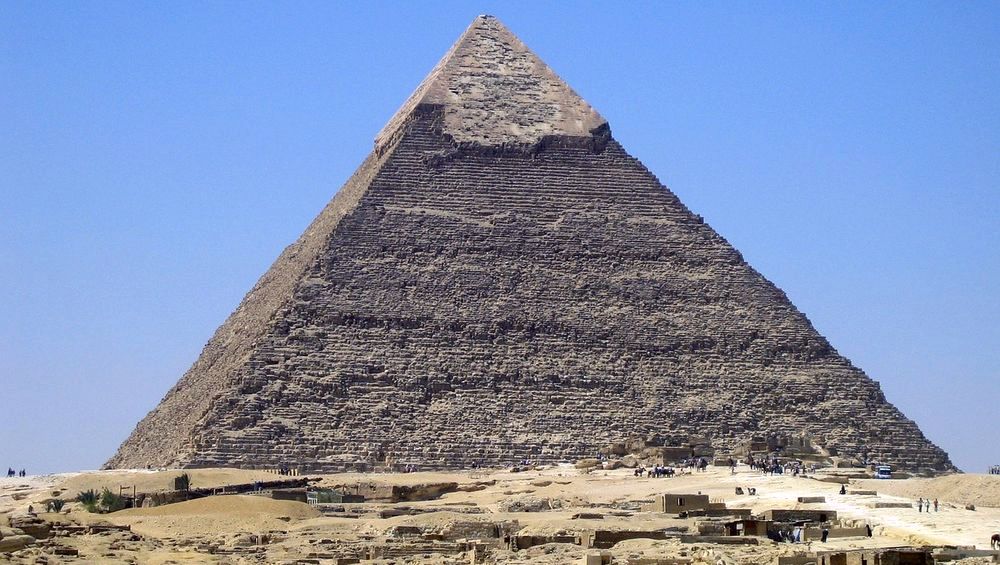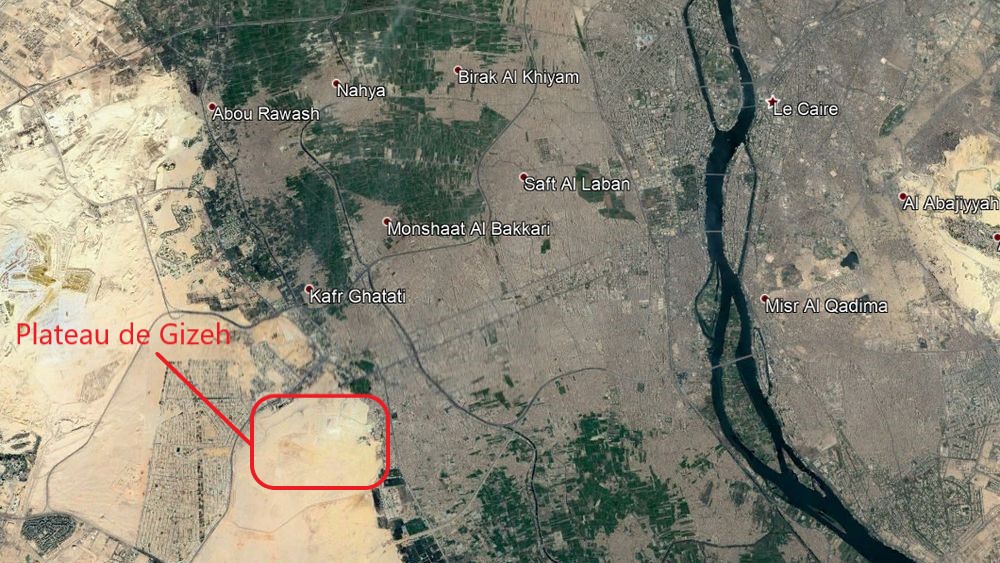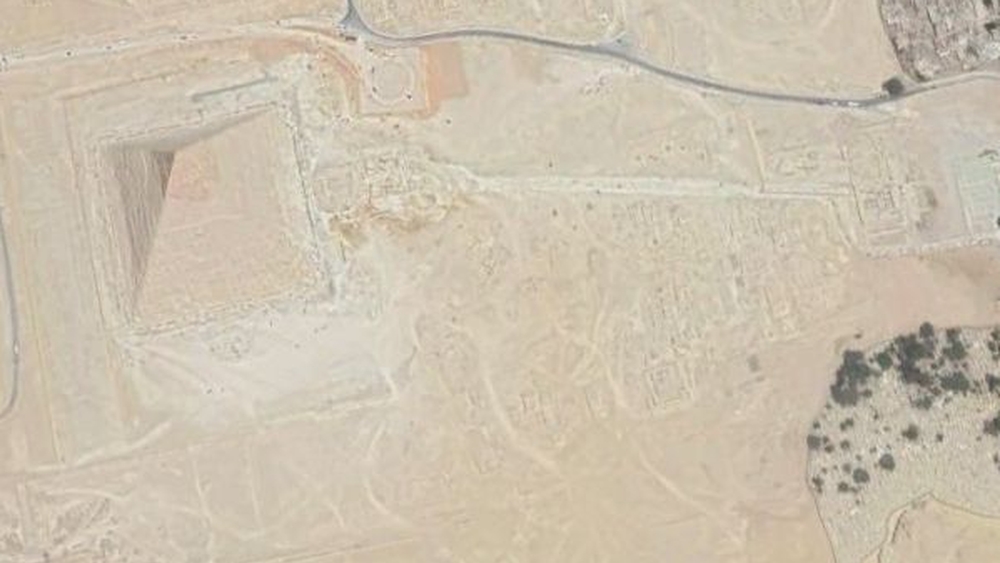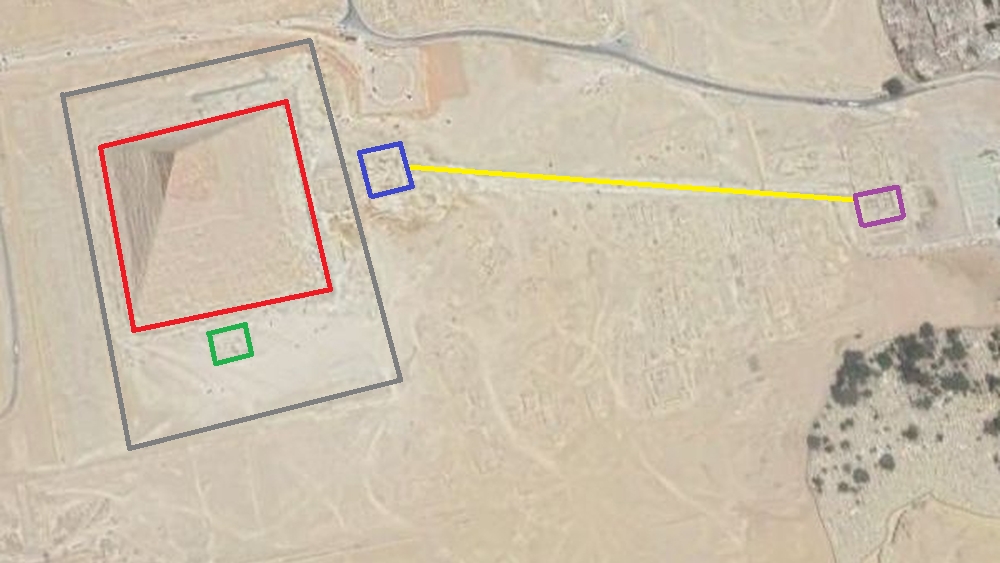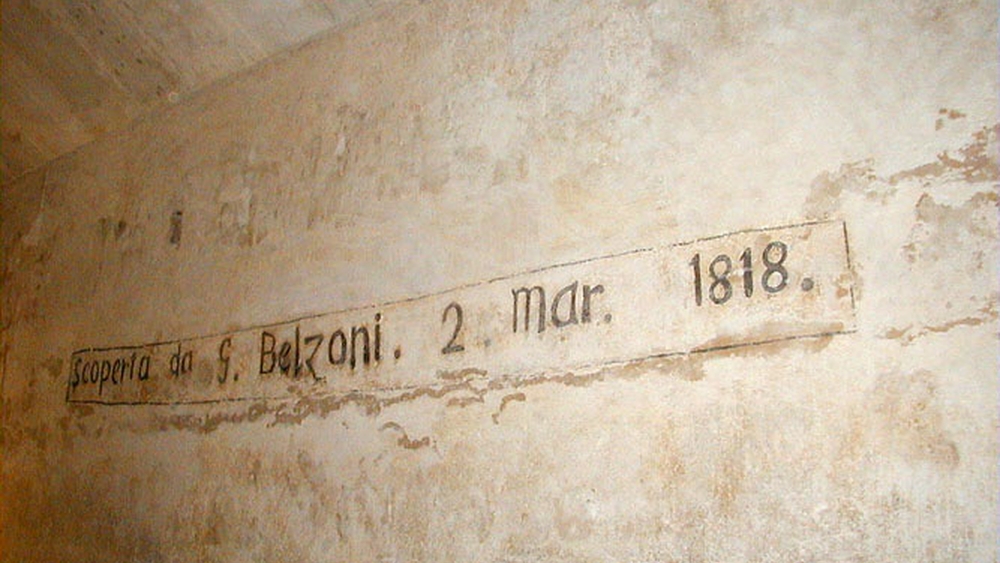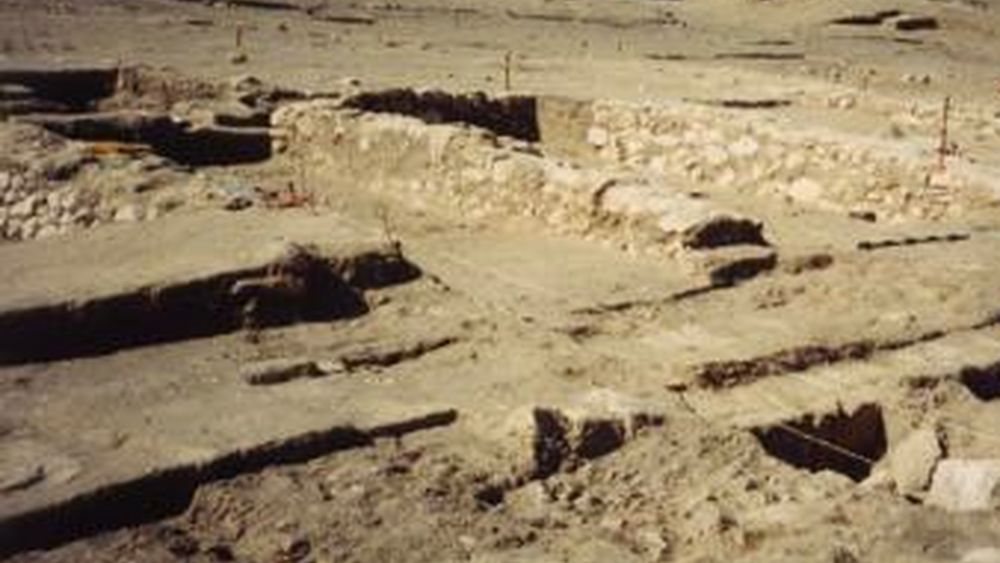Seeming to dominate the famous plateau of Giza where there are two other pyramids, that of Khafra is actually slightly smaller than that of his father Khufu, but this impression comes from the fact it is built on a rocky nipple, so the summit is higher, but the pyramid of Khafra is beautiful and much smaller than its father, Khufu.
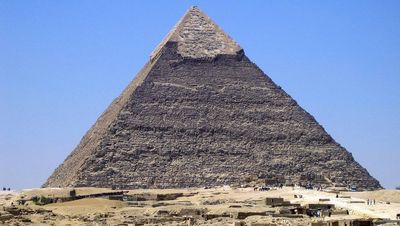
The pyramid of Khafra
She was initially 143m tall for a 215m square base, and she is the centerpiece of a funeral complex quite comparable to her father's. The Sphinx is associated with Khafra, to which he would have lent his features. But the Great Sphinx is a unique monument, close to the Khaphren complex but distinct from it.
Historical and geographical context
The pyramid of Khafra is the last of the giants. In the chronological order of building the pyramids, there was first the Pyramid of Djoser, the very first pyramid in Egyptian history. It is a monument to 6 degrees, built by stage. Djoser was the first pharaoh of the Third Dynasty, a dynasty that saw the birth of the pyramids as a funerary monument of the Pharaohs.
The successors of Djoser each built their pyramid, but few succeeded completely. Some were never completed on their terms, others were built, but eventually collapsed. Then, there was a period known as the provincial pyramids, pyramids scattered in various areas of the Nile Valley, far enough away from the capital Memphis. They were small-sized pyramids, culminating between 15 and 25m, but mostly drafts for later.
The first pharaohs of the Fourth Dynasty tried several times to make perfect pyramids with smooth faces. It took several attempts to Pharaoh Snefrou, father of Khufu, to achieve it: The rhomboid pyramid is the example, its slope had to be revised downward over the course of construction. The red pyramid of Snefru was the first perfect. The techniques acquired during this time served for the following stage: The Age of the Giant Pyramids.
The giant pyramids are few, that of Khafra is the last one. They are large pyramids as their names indicate, they are more than 100m high. Before Khafra, there was that of Khufu, his father. Between the two there was another Pharaoh, also son of Khufu, but much less known: Djedefrê. The latter also launched the construction of his tomb during his reign, but he was unfortunately brief and his pyramid was never completed.
Learn more about List of the pyramids of Egypt.
Geographically, the pyramid of Khafra lies to the southwest of that of Khufu, a few hundred meters away. It is on the Giza Plateau, a limestone plateau southeast of Cairo nowadays almost surrounded by the Cairo agglomeration.
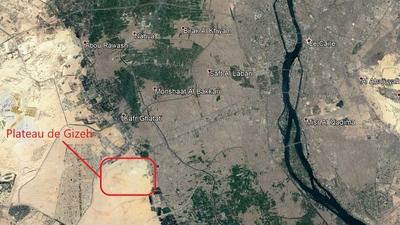
Location of the Pyramids of Giza
Learn more about the mlocation of the plateau of Giza.
Who was Khafra?
Khafra was the 3rd pharaoh of the 4th Dynasty, the one that built the 3 great pyramids of Giza. Son of Khufu, he ruled between -2518 to -2492. These dates are approximate of course, the specialists do not necessarily agree between them.
It filters very little information about the reign of this distant pharaoh. It seems however that his reign was good, and that the king was appreciated, but this state of affairs is only the result of deduction compared to the various archaeological discoveries made during this period. It is therefore rather unreliable, it gives rather a positive trend to life during this period.
Learn more about the biography of Khafra.
Overview
The funeral complex of Khafra is similar to that of Khufu and Menkaure. It consists of a pyramid (in red), the main element, an enclosure (in gray), a high temple that is near the pyramid (in blue), a low temple, several hundred meters from there (in purple), and a causeway that connects the two temples (in yellow). The complex also has an annex pyramid (in green) and there is an important link between this funerary complex and that of the Sphinx , which also has a nearby temple. at the lower temple of Khafra and in addition of the same size. In addition, the upper part of the complex was protected by two concentric enclosures, one close to the pyramid, the other encompassing the annex pyramid.
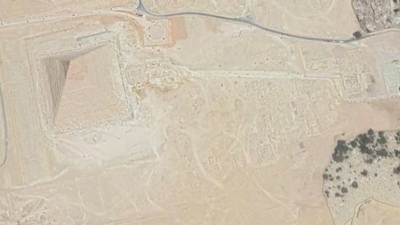
Khéphren Funeral Complex
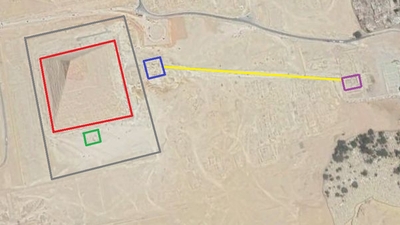
Khéphren Funeral Complex
The high temple is not glued to the pyramid, there is a gap between the two. The lower temple is in a very good state of conservation for such an old building. It should be noted that this complex has only one pyramid whose utility has not yet been found. It seems that she had only a cult role, but it is also possible that the tomb of one of the queen of Khafra.
Finally, the pyramid of Khafra has 5 pits with solar boats, arranged as on that of Khufu. Unfortunately and unlike his father's, no boat was found inside.
Differences with the Khufu complex
As expected, the funeral complex of Khafra is different from that of his father Khufu. First of all, the exterior cladding was not quite the same since like that of Mykérinos, that of Khafra had on the first rows near the ground a coating of granite and not in limestone from Tourah. This limestone existed, but from a certain height.
Another difference, the Khufu pyramid was built on a perfectly flat ground, flat. That of Khafra started from a small hill which was buried under the massif, allowing to gain a large amount of blocks. The problem that arose was the floor of the pyramid, which was not flat, suddenly. The Egyptians of the time had to cut the hill on the terrace, then cut blocks of stone corresponding to the widths of the terraces. Thus they were able to reach, after a certain number of levels, a perfectly flat surface.
Then, we can evoke the presence of a single pyramid annex, a pyramid of worship, while that of Khufu does have a pyramid of worship, but especially it has 3 pyramids annexes for two Brides and mother of Khufu, although these attributions are not definitive.
Detail of buildings
Pramid
The pyramid of Khafra initially measured 143.87, but it is today only 136m because it has lost its pyramidion, the small pyramid of the summit. It has a square base of 215.16m, with an error of only 8cm, or 0.04%. We will say what we want, but manage to build a pyramid of more than 200m side with such a small error, it is a real feat if we consider the few technical means that the builders at the time. Its inclination is 53 °, 2 ° more than that of Khufu. The pyramid is aligned on the 4 cardinal points with a minimal deviation at the base, and even less at the top because there is a very slight torsion of the faces, totally invisible to the naked eye.
The massive
The pyramid is made of large blocks of limestone that were extracted on site, on the Giza plateau. The blocks were extracted from the ground, then cut roughly to the right size by tailors before being placed on large wooden sleds. These sleds were dragged on the ground or on wooden logs until elevation system which could vary from pyramid to the other. The mechanism used on Khaphren's pyramid is unknown to us, but it was most probably a simple ramp. The sleds were pulled by unskilled workers, they were actually local peasants who had nothing special to do during the bad season and were hired on the construction site.
The blocks that form the massif of the pyramid of Khafra are coarse, only their heights are of great precision, this to ensure that layered layers, the pyramid remains horizontal. But between the blocks, the joints are wide, and there is no mortar as was the case on the pyramid of Khufu. Blocks that were close to the faces were pruned more carefully, and their fixtures were of better quality.
Finally the coating covered the entire pyramid once, it is made of limestone Tourah, an underground quarry east of Cairo. The first rows, the lowest, were in pink granite from a quarry in Aswan, southern Egypt. The granitic stones had to be transported to the shipyard by ship. Some have a gigantic size, it is by far the pyramid that has used the largest stones of all ancient Egyptian history.
Galleries
The interior of the pyramid of Khafra offers as a set of simple galleries, quite close to what exists on that of Khufu.
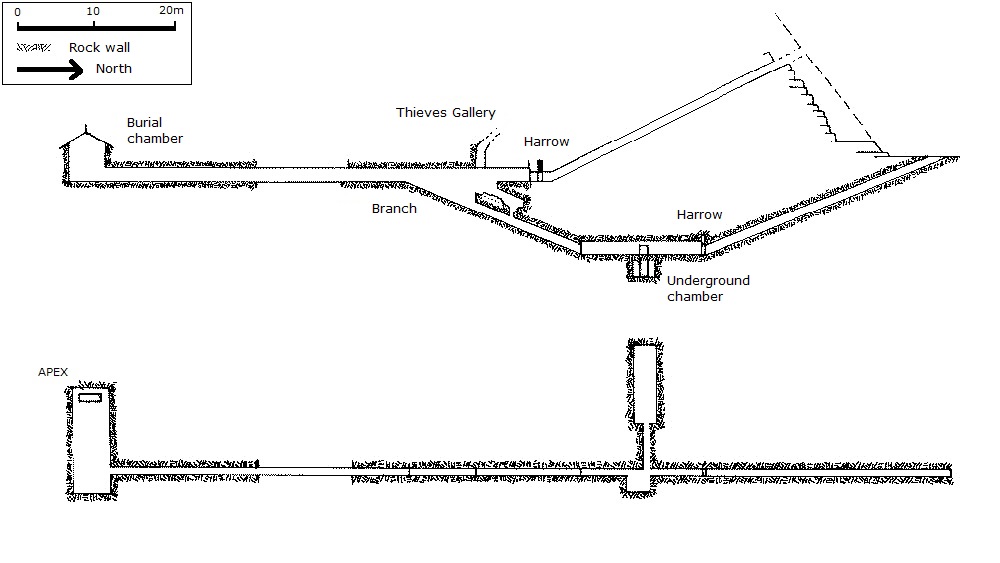
It has 3 entrances: The main one is on the North face, at 12m90 high and 12m45 of the axis of symmetry, towards the East. It is a normal entry, without specific specificity. The second entrance was hidden under the pavement of the courtyard, in the axis of the first entrance. Finally the third entrance is higher than the main entrance, it is a hose that was dug by thieves.
From the main entrance a gallery drops down about 26 °, carved into the massif. Its walls are made of heavy granite blocks richly decorated. Thirty-seven meters further, a portcullis blocked the passage. It was an important defensive element, a heavy harrow that anchored deep into the ground. With its 1m83 on 37cm thick, it was equipped with moldings with repetitive patterns. Last the harrow opens a horizontal corridor of a meter 78 high and 11m long leading to an intersection of corridors. If the gallery continues straight, it is also possible here to take two other galleries going down. The first is plugged almost immediately, as if the work had been stopped voluntarily to do the second, which sinks back down, deeper into the ground.
If you stay in the main gallery you end up at the end of the corridor in the funeral chamber. It is a rectangular piece made of granite wall whose walls are neat. The ceiling is made of huge blocks of granite arranged in herringbone and with almost perfect equipment. The floor of the chamber is natural rock, except for its western part where it was paved. The sarcophagus of Khafra is caught in these slabs. It is made of a single piece of granite of very good quality.
If we go back and take the lower gallery, we see that the corridor goes down to a point where it becomes horizontal, before we come across another harrow behind which the gallery continues to the entrance under the outdoor courtyard. When the gallery is horizontal, a hose goes east and leads to the lower chamber. The latter is a fairly long rectangular piece with a chevron ceiling. The entrance was equipped with a double wooden door now disappeared.
Writing
The burial chamber of Khafra was discovered in 1818 (on March 2, exactly) by an Italian, Giovanni Belzoni. At that time archeology was not as attentive as it is nowadays, so, out of pride for having made this discovery, he inscribed a mention in the room, on its walls. Even today we can read this:
Découverte par G. Belzoni
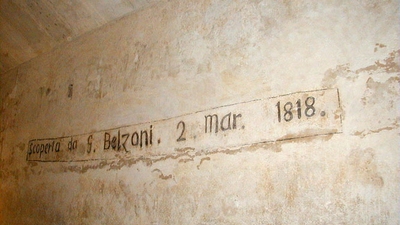
Writing of Belzoni
The temple high
The top temple of the Khéphren funeral complex is a heavy limestone building 48m by 111 facing east-west. It is not directly attached to the pyramid but is very close to its east wall. On the other hand, it adjoins the surrounding wall that once surrounded the pyramid, so we could not go around.
The walls were tall and massive, they were made of local limestone but adorned with Aswan's heavy pink granite stones, internally. Externally the walls of the temple were covered with Tourah stones, the same covering as the pyramid itself. This choice is undoubtedly a bias of aesthetic standardization of the whole funeral of the pharaoh. Some of these wall stones weigh the record 135 tons, they are the heaviest ever moved by the Egyptians of the old empire. Sloping walls were a common construction style for temples of that time. Here, the facing stones form an angle of 81 ° 50 to the ground, giving the building a stocky appearance.
Nowadays this temple is strongly degraded but not completely in ruins, the walls are often still standing, although strongly eroded.
Map
The plan of the high temple approaches, by far, that of the low temple. It is described by a succession of three hypostyle rooms (whose ceiling is supported by columns) leading to a courtyard. The three hypostyle rooms had respectively 8, 4 and 2 granite pillars. The inner courtyard, it was endowed with 12 statues of Khafra, they were against the walls of the court, except at the level of the right angles. The courtyard also had an altar and a small canal in the center of the floor. As the courtyard was 5cm lower than the rest of the halls and corridors of the temple, the rain water ran down the courtyard and flow through this small canal.
All this part of the temple, to the west, is connected on the one hand to the rising ground of the funeral complex, on the other hand to the apartments and rooms of worship reserved for the priests. These apartments contained a few shops and a sacred chamber. In practice, the west wall of the courtyard gives access to five alabaster-floored rooms, identical in size with the exception of the middle one, which is slightly larger. South of these 5 rooms begins a corridor which bypasses them and opens on 5 other rooms, obviously pieces destined to store the objects of worship. Behind them is a rather large room with a niche on the wall, in the center, containing a stele shaped like a false door.
In total the temple has 16 passages. Each is decorated on its lintel and its hieroglyphic jambs, it is the name of the king and his titulatures, repeated several times. From a decorative point of view, the corridors were also decorated with bas-relief drawings. If there are only three decorated blocks left today, it was probably the whole temple that was.
To enter the temple there was only one passage, by the roadway. It should be noted that this model of high temple will be taken by most of the following pharaohs until the 6th dynasty.
The temple of the valley
The lower temple, also called temple of the valley, is much better preserved than the high temple. It is in fact the best preserved of all the buildings of the old empire, and it alone allows one to get an idea of how these temples were at the time. Located at the other end of the rising road, it also served as a landing pier for the boat bringing the pharaoh's body to its funeral complex.
It is placed against another temple which has, a priori, nothing to do with this one: The temple of the Great Sphinx.
Purpose
The role of this temple has never been clearly identified, but if one makes an analogy with the lower temples of funerary complexes of the same period, one can imagine that it was used to perform the embalming of the pharaoh. His embalmed body was then transported to the high temple before joining the sarcophagus in the pyramid.
Architecture
This temple has a curiosity, its walls are in limestone but unlike other temples, they are not made of successive layers of identical stones, they are instead made of stones of different sizes assembled in the manner of a puzzle, a technique which improves the stability of the building. These walls were then covered with pink granite from the quarries of Aswan, as for the high temple and galleries of the pyramid.
Map
The plan of the temple is a simple square with three openings, two in the East, and one in the West. The latter is connected directly to the rising road, while the other two face the platform where they were flanked each two huge Sphinx 8m long by 2 wide and lead to two vestibules. These vestibules are connected to an antechamber common, 20m long, oriented North-South and covered with alabaster slab. In the floor of this room is a well in the bottom of which was found the magnificent statue of Khafra diorite which is nowadays exposed to the Cairo Museum.
The antechamber opens on a large hypostyle room in the shape of T and having two passages at its ends. The northern end is the entrance to the roadway, the southern end serves three long rooms and probably used as stores.
Pavement
The causeway was a long, narrow hallway that connected the low temple to the high temple. Covered passage, its walls were in limestone 5m thick and 3m high and they were covered with granite blocks carefully cut and matched.
The rising ground of the Khafra complex was 494.60m long exactly. Its ceiling was pierced with regular openings to let the light, but suddenly, rain could also pass and to avoid the inconvenience due to water, the architects planned a small evacuation channel on the ground. The presence of such a channel proves that the rain was relatively common at the time, in this region, we were not on the same climate today, much more arid.
The pits of solar boats
As on the complex of his father Khufu, that of Khafra had 5 pits with boat, alas found empty. These are large, long, narrow holes that were to receive the boat used to bring the pharaoh's body to the lower temple. This boat was supposed to be dismantled and put in one of these pits. There could very well be several, hence the interest of having several pits. If the pyramid of Khufu revealed the presence, then the extraction, of two boats in good condition, here no boat was found there, alas, we have just the pits.
We do not know if they were left empty or if time definitely destroyed the fragile pieces of wood that made them.
These pits were located one behind the other along the walls of the upper temple, with the exception of one located at 90 ° and bordering the wall.
The annex pyramid
The pyramid annexed to that of Khafra is nowadays completely destroyed. All that remains is the underground structure composed of a simple descent on the North face in the form of a rectangular gallery leading 10m below to a rectangular room devoid of any particular elements except the wooden support of a missing statue. The support was found in disrepair, of course.
This pyramid, which we call today with the code G2a (G of Giza, 2 of the 2nd pyramid, has for the numbering of the pyramids annexes, here the first and only), had to measure approximately 20m of side and have a slope of 53 °, the same slope as the main pyramid. It is exactly in the axis of the south face, exactly 28,50m from the first row of stones.
It seems that this annex pyramid was a pyramid of worship, not the tomb of a queen.
Fortified enclosures
The funeral complex of Khafra was protected by two concentric enclosures. The first was 10m50 from the bottom of the pyramid, the second at 69m50. The area enclosed between the two was blank of any building, except for the pyramid of worship, the famous pyramid annex 2Ga.
The high temple crossed the two enclosures, one close to the roadway, the other close to the pyramid. To get to the pyramid, we had no choice but to cross the temple high, and therefore the roadway, and therefore the temple down. Finally, the entrance to the pyramid is actually one of the two entrances to the lower temple, on the wharf.
Construction
There is little information on the construction of the Khafra pyramid, that of Khufu is more documented nowadays. Since they are similar and built at close dates, we can imagine that the techniques used were the same, roughly.
There were two types of workers: artisans and peasants. The craftsmen were specialized workers, usually in the size of stones, carving, polishing, measuring. The peasants were farm laborers working in the fields year-round and who, during the months of the year during which they had no work, were hired on the construction sites. They were mainly used to tow heavy loads.
The workers were organized in groups of 20 people, gathered in groups of 200 people, themselves gathered in groups of 1000. It is not known how many groups of 1000 were working on the pyramid of Khafra, but that of Khufu used 20 , to compare.
Learn more about the construction of the pyramids of the Giza plateau, and more generaly about the construction of the pyramides of Egypt.
The village of workers
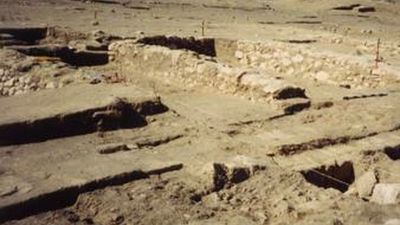
The village of workers
To be able to work on the site, it was necessary to house and feed the employees. It was the role of the village workers, also called "city workers". It is a city 500m east of the pyramid, south of the quays of the lower temple. This place was separated from the rest of the construction site by a high wall and sheltered the population of workers with all that was necessary for their lives there: Bakery, blacksmith (or rather, craftsmen working copper), doctor, etc. This village was discovered recently and has been the subject of studies proving that they were free, well-fed workers. It seems that only the artisans were housed in this working-class city. The peasants, passing through the building site, were instead housed in canvas camps at the foot of the pyramid.
However it is possible that this place was built after the construction of the pyramid of Khufu, perhaps it was during the construction of that of Khafra.
As far as food is concerned, you should know that the Giza plateau did not look the same at the time, compared to today. In -2650 the surrounding nature was rather similar to the savannah. Shepherds kept flocks that came from the Nile delta, several dozen kilometers to the north, on land more suitable for farming. These herds fed the village and all the people working on this site. We can not be sure, but it is likely that the living conditions on the site are better than those of an ordinary farmer working his fields near the Nile.
Learn more about The village of workers of the plateau of Giza.






